AMD Carrizo Part 2: A Generational Deep Dive into the Athlon X4 845 at $70
by Ian Cutress on July 14, 2016 9:00 AM ESTStock Comparison: Legacy Benchmarks
Some of our legacy benchmarks have followed AnandTech for over a decade, showing how performance changes when the code bases stay the same in that period. Some of this software is still in common use today.
All of our benchmark results can also be found in our benchmark engine, Bench.
3D Particle Movement v1
3DPM is a self-penned benchmark, taking basic 3D movement algorithms used in Brownian Motion simulations and testing them for speed. High floating point performance, MHz and IPC wins in the single thread version, whereas the multithread version has to handle the threads and loves more cores. This is the original version, written in the style of a typical non-computer science student coding up an algorithm for their theoretical problem, and comes without any non-obvious optimizations not already performed by the compiler, such as false sharing.
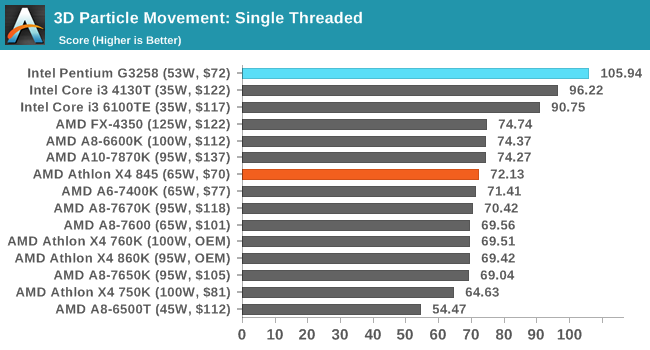
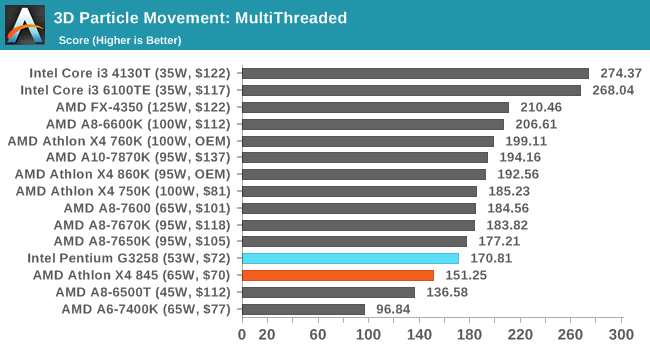
Despite 3DPM v1's coding issues, the multithreaded result is a lot closer than I had originally expected.
Cinebench 11.5 and 10
Cinebench is a widely known benchmarking tool for measuring performance relative to MAXON's animation software Cinema 4D. Cinebench has been optimized over a decade and focuses on purely CPU horsepower, meaning if there is a discrepancy in pure throughput characteristics, Cinebench is likely to show that discrepancy. Arguably other software doesn't make use of all the tools available, so the real world relevance might purely be academic, but given our large database of data for Cinebench it seems difficult to ignore a small five minute test. We run the modern version 15 in this test, as well as the older 11.5 and 10 due to our back data.
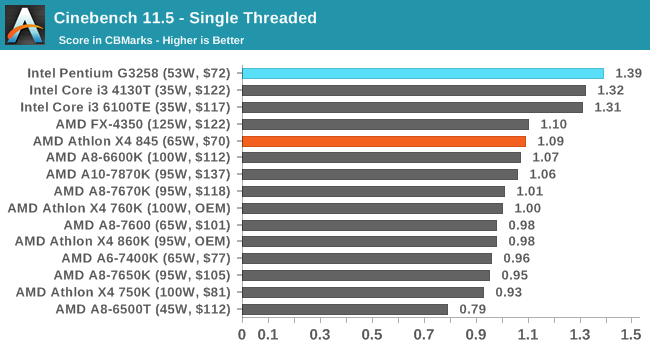
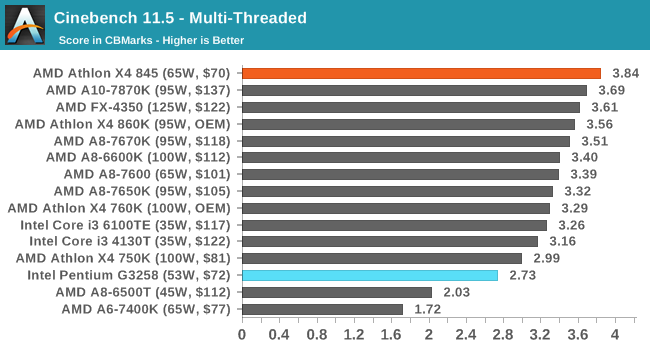
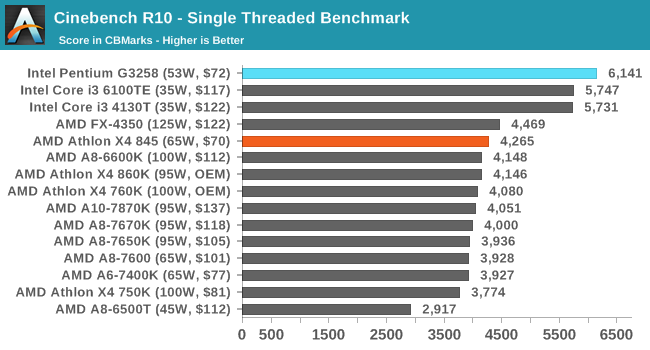

In both CineBench instances we see the high IPC of the Pentium take a 33-50% lead, whereas moving to multi-threaded puts the X4 845 firmly in the driving seat.
POV-Ray 3.7
POV-Ray is a common ray-tracing tool used to generate realistic looking scenes. We've used POV-Ray in its various guises over the years as a good benchmark for performance, as well as a tool on the march to ray-tracing limited immersive environments. We use the built-in multithreaded benchmark.
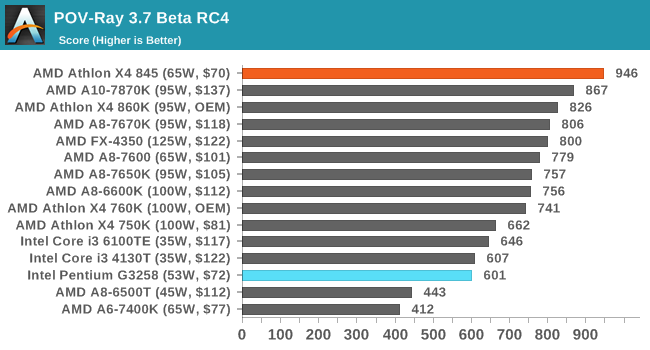
POV-Ray fully exploints all the threads in the system, and the latest AMD microarchitecture helps here as well, pushing the X4 845 beyond the other AMD CPUs in this test and comfortably over the Pentium and low-power Core i3 parts.
TrueCrypt 7.1
Before its discontinuation, TrueCrypt was a popular tool for WindowsXP to offer software encryption to a file system. The almost latest version, 7.1, is still widely used however the developers have stopped supporting it since the introduction of encrypted disk support in Windows 8/7/Vista from 5/2014, and as such any new security issues are unfixed.
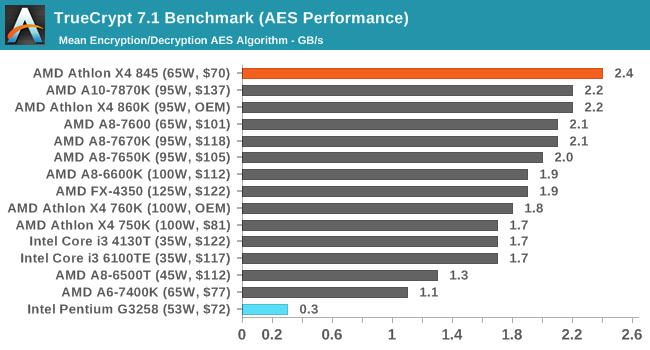
The Pentium lacks AES acceleration, which is available on Core i3 parts and up, which explains the Pentium's low performance here. The Carrizo microarchitecture pushes the 65W part ahead of all the other 95W/100W/125W parts.
x264 HD 3.0
Similarly, the x264 HD 3.0 package we use here is also kept for historic regressional data. The latest version is 5.0.1, and encodes a 1080p video clip into a high quality x264 file. Version 3.0 only performs the same test on a 720p file, and in most circumstances the software performance hits its limit on high end processors, but still works well for mainstream and low-end. Also, this version only takes a few minutes, whereas the latest can take over 90 minutes to run.
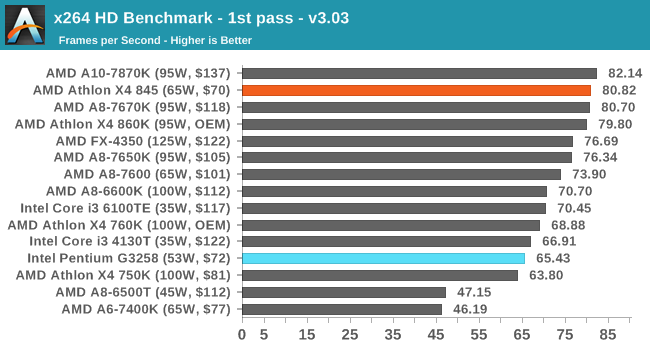
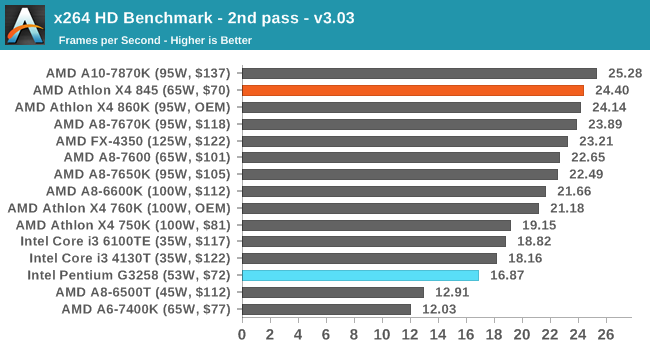
7-zip
7-Zip is a freeware compression/decompression tool that is widely deployed across the world. We run the included benchmark tool using a 50MB library and take the average of a set of fixed-time results.
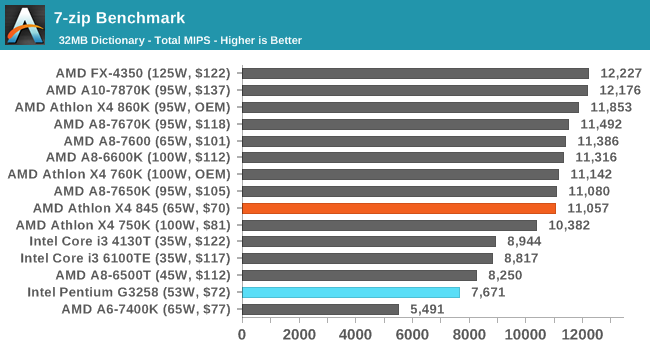










131 Comments
View All Comments
TheinsanegamerN - Monday, July 18, 2016 - link
carrizo is gimped because it's a bulldozer product. AMD should have stuck with k10 cores on their APUs.Lolimaster - Saturday, July 16, 2016 - link
Unless they axed BR in favor of non-APU Zen and bring Raven Ridge early 2017.Lolimaster - Saturday, July 16, 2016 - link
They were nice in 2014.We should have a nice 20nm 768SP APU in 2015 with a full L2 cache Excavator and fully mature 896SP 20nm early this year.
Remember the A8 3870K? That APU was a damn monster only hold back from being godly cause of their sub 3Ghz cpu speed, what we had after?
400SP VLIW5 2011 --> 384 VLIW4 2012 --> 384VLIW4 2013 --> 512SP GCN 2015 --> 512SP GCN 2016
Intel improved way faster (non "e" + edram igp's are near A8 level from being utter trash when the A8 3850 was release).
serendip - Saturday, July 16, 2016 - link
Still not attractive when a cheap Pentium kills it on single-threaded performance, which is what matters in real-world usage. AMD needs to make tablet chips to take the place of Intel Atoms. I'd love to have a 2W TDP APU with double the performance of Atom GMA graphics and similar single-threaded performance.One can dream...
TheinsanegamerN - Monday, July 18, 2016 - link
AMD powered surface 4 (non pro model) with LTE would be perfect.Too bad AMD abandoned that market. They had a good thing going with their cat cores, but they let that line wither on the vine.
leopard_jumps - Saturday, July 16, 2016 - link
Thanks for the review ! You should include Intel i7 for comparison . Here :http://www.guru3d.com/articles_pages/amd_athlon_x4...
Meteor2 - Saturday, July 16, 2016 - link
The latest microarchitecture from AMD based on the x86 instruction set was given the codename Excavator, using the fourth generation of AMD's Bulldozer cores, called Carrizo cores.' - Can someone explain that to me? Or are we saying these are Excavator Bulldozer Carizos??Calculatron - Saturday, July 16, 2016 - link
Fourth generation Bulldozer-style cores, named Carrizo.The architecture type/family is Bulldozer, this version/generation is called Excavator, and this specific kind of core is called Carrizo. The mobile version is called Carrizo-L, I think?
If you, or anyone you know, bought an FX-8350, they bought a second-generation Bulldozer product, and it was called Piledriver. Anyone who bought the A10-5800K also bought a second generation Bulldozer product, but it was called Trinity. Both of these were Vishera, since they were second-generation.
Lolimaster - Saturday, July 16, 2016 - link
No.The 1st APU platform featuring piledriver cores was called Trinity,
The 1st and only desktop FX platform featuring piledriver cores was called Vishera.
Calculatron - Saturday, July 16, 2016 - link
This is correct: I confused, and swapped, Piledriver and Vishera.Both the A10-5800K and FX-8350 were Piledriver, but they were Trinity and Vishera, respectively.